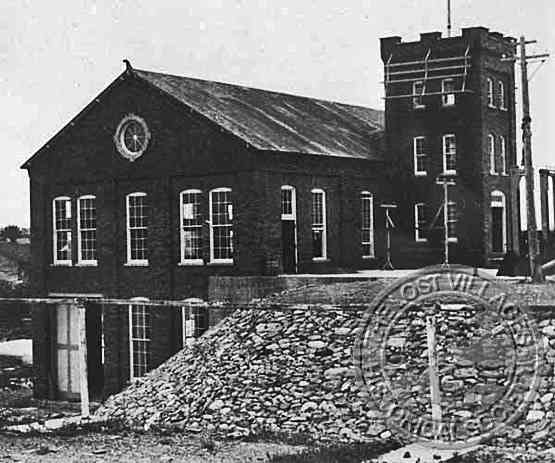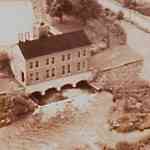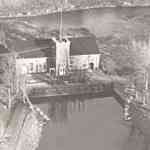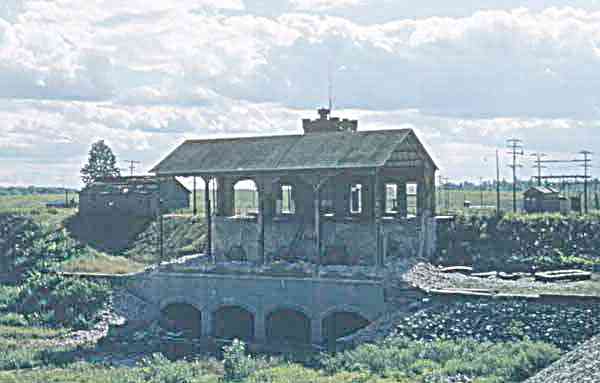Power House
It’s worth mentioning that there’s a powerhouse on Victoria island in Ottawa, Ont. that predates the Mille Roches powerhouse by a couple of years. The Ottawa counterpart is still in operation and is feeding power into the local grid. I was fortunate to have had the opportunity to tour this facility which isn’t open to the public, because of an acquaintance who knew someone who worked there at the time. As if it couldn’t get any better, the day of our visit (20 years ago) corresponded with the headpond having been drained for maintenance reasons, this allowed us to see inner workings that helped explain some of the mysteries surrounding the Mille Roches Powerhouse.
This old powerhouse, as with the one in Ottawa, has horizontal turbines and generators. Unlike the
Ottawa counterpart this powerhouse has headgates to shut off the flow of water to the turbines and as divers found out, restrict access to the wheelpits and the turbines themselves. The trashgates in front of the headgates are still in place as are the large winches/gears used to lift the headgates. There were four wheelpits but only two housed turbines with a third one used only for the “exciter”, needed for charging the generator so it could then produce power. The fourth wheelpit is partially closed off but entry with scuba gear is a tight fit but well worth the effort and an odd square hole in the large dome that covers this wheelpit, allows for some light to penetrate. Scuba diving inside this wheelpit is one of my fondest memories.
North view of the Mille Roches Power House
I understand that Thomas Edison himself was present for the grand opening and ceremoniously “threw the switch” and the station started generating power. The first customer for electricity was the Cornwall Canal itself, which had lights running along most of it’s eleven mile length from the locks at the Cornwall harbour to the western entrance at Lock 21, just east of Dickinson’s Landing. Later as more local factories began to upgrade their machinery, more customers began to appear. The late Mr Archie Eastman was an operator here until the powerhouse closed and he mentioned how they would first call to the cottonmill in Cornwall and inform them that they were about to start generating power. (I won’t get into the technical details of that practice here) Mr Eastman also went into detail describing the various ways of controlling the output of electricity but the primitive devices inside the control room were the most interesting and were capable of generating large amounts of heat as an unavoidable byproduct. I’ve seen the remains of some these early devices, apparently cast away into the tailrace. The heat generated was from what today would be consider wasted energy as they tried to maintain a steady flow to electricity despite the fluctuations within the headpond, in this case Bergin Lake itself.
Different photos were of course taken different years and somewhere during the history of this structure the tower had a large metal vent affair on top of the tower. This metal appendage still rests on the bottom in front of the trashgates in the intake canal. The metal domes that covered the wheelpits containing the turbines are covered with debris and bricks from the final demolition.
A rare colour photograph of the tailrace behind the Powerhouse, flowing down the last remaining stretch of the original north channel of the St Lawrence river at Mille Roches. There is now 75 feet of water over this site and everything in this photograph is gone underwater.
The photograph below shows the powerhouse being demolished, most of the trees have been cut down and the north channel has been dried up for the construction of the new power dam. The remains of the generators can be seen laying on the ground to the right of the building, there the round circular pieces, savaged for their copper. Only the two turbine shafts and some interesting operating hardware like the two reciprocating shafts and gears that opened and closed covers over the turbine blades still adorn the wall of the generating room. The metal vent stayed to the end and is the mushroom shape on top of the tower.
WHAT REMAINS TODAY
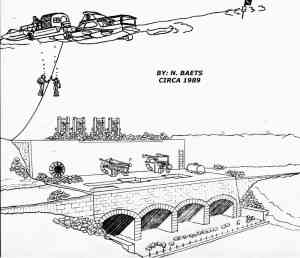 This wonderful sketch was done by Mr. Nick Baets, an avid scuba diver from Ottawa almost twenty years ago. Along with the layout of what remains to be seen of the powerhouse, he included the entire flotilla of boats and dive platforms that were there that day 2 decades ago for a great dive social put on by a local chapter of Save Ontario Shipwrecks. The divers surveyed most of the site and documented various structures and artifacts on many levels of this site.
This wonderful sketch was done by Mr. Nick Baets, an avid scuba diver from Ottawa almost twenty years ago. Along with the layout of what remains to be seen of the powerhouse, he included the entire flotilla of boats and dive platforms that were there that day 2 decades ago for a great dive social put on by a local chapter of Save Ontario Shipwrecks. The divers surveyed most of the site and documented various structures and artifacts on many levels of this site.
The site is divided into three levels roughly at 35, 55 and 75 feet of depth, depending on the level of Lake St. Lawrence. There are far more bricks strewn about the site that what is represented in the drawing but most of the large equipment is easily accessible. A favourite spot is inside the wheelpit on the left, once inside the diver is treated to the inside view of the headgate. The winches above the headgates offer lots to see and a diver can drop down underneath the wooden walkway between the closed headgates and the
trashgates which shed a unique light through the bars onto schools of bass and perch hiding inside from the current and larger predators.
The middle level were the generating room was located and the stone arches below where the water was discharged from, is solid concrete and stone and should withstand the test time and offer visiting divers something to see of the original lost villages for many decades to come.

